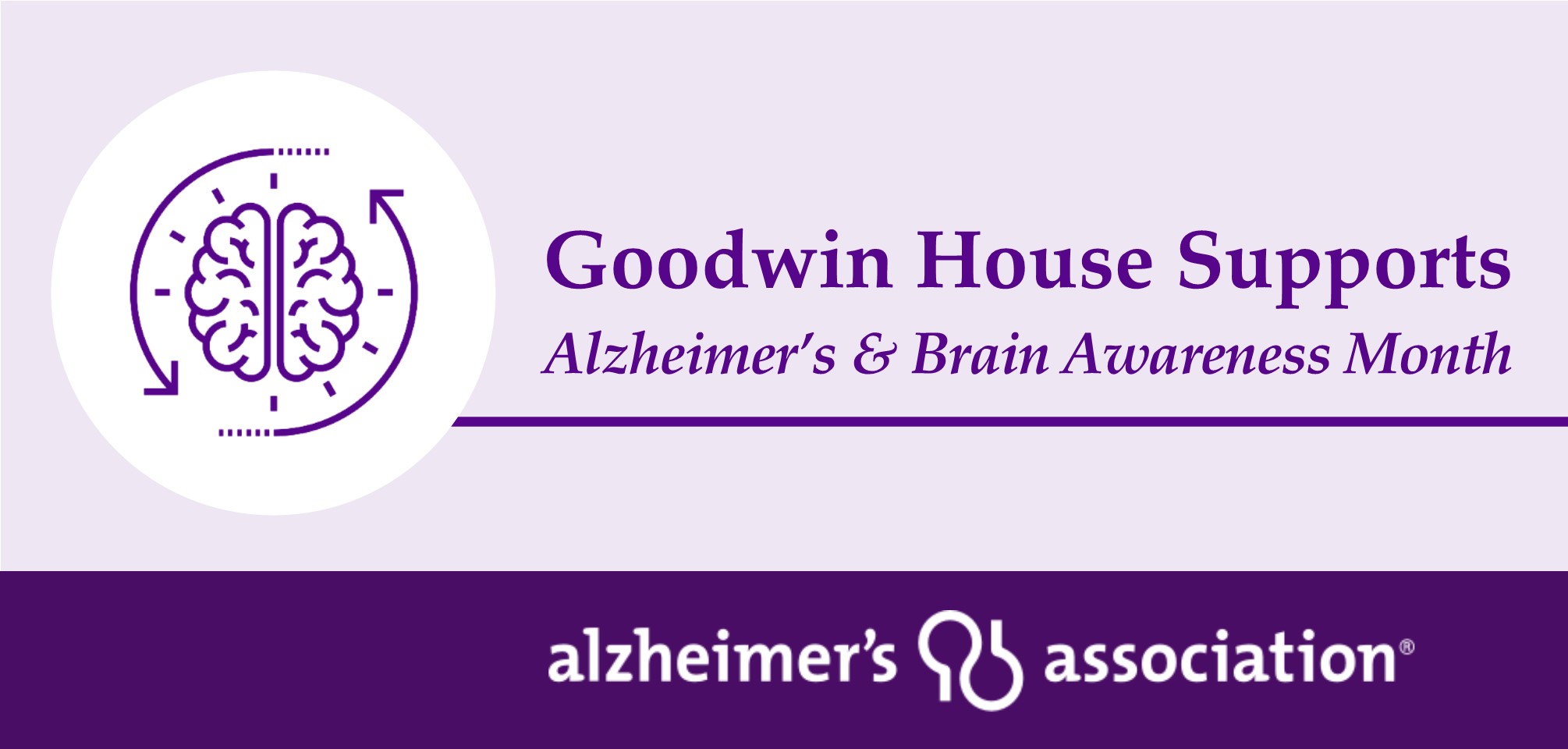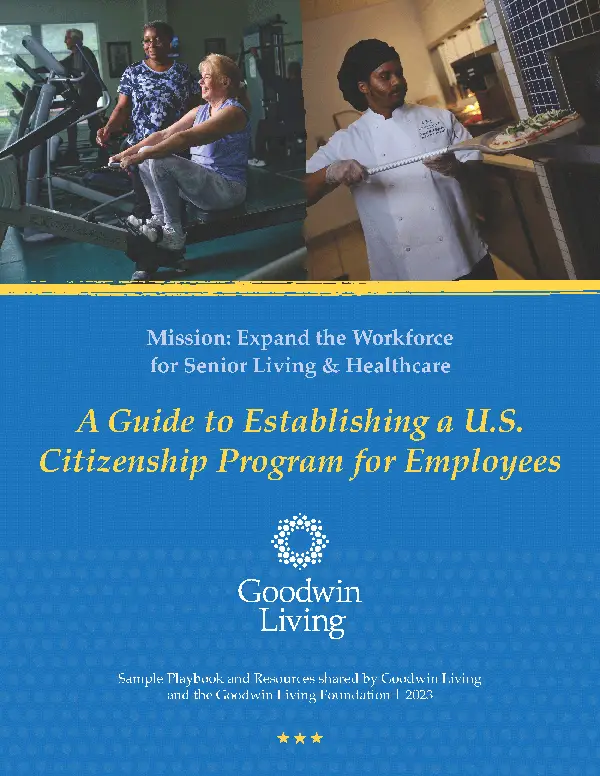
Live Vibrantly - June 25, 2021
By Jessica Fredericksen
As we continue to recognize and support Alzheimer’s and Brain Awareness Month, we’re sharing easy activities you can do to engage individuals with dementia. For more in our series for Alzheimer’s and Brain Awareness month, see our earlier article on Four Tips for Better Brain Health.
Sensory stimulation has been researched and established as a simple and useful tool for those of us who care for individuals in any stage of dementia. Memory support practitioners have been using this approach for many years. Family and friends can also apply these simple techniques that we practice in our own care settings at Goodwin Living.
The idea behind this technique is simple: Everyday items and activities can awaken the senses—touch, smell, taste, hearing and sight—and elicit a positive feeling or response in those living with dementia.
Activities for individuals with dementia should be creative and fun. They should also be meaningful to the individual.
We can find various ways to engage individuals with tasks that are familiar and meaningful to them. Equally helpful are activities that spark joy and sensations that are relaxing. Below, you’ll find 14 easy ideas that can help you get started in engaging persons with dementia.
If you are caregiving as a family member or friend, draw on what you know about your loved one to find the best activities for them. If you are caring for someone who loved home improvement projects, consider items 10 and 14 in the list below. If they loved caring for their home and children, consider items 1, 2 and 5. And remember, these ideas can be just the start and might inspire you to think of other ways to engage with your loved ones.
Whenever possible, sit with the individual while they are working on these activities and use the time together to spark conversation. Be present with them in the moment and enjoy your time together.
Fill a small basket with small items (clean baby clothes or hand towels work best) and ask the individual to help you sort and fold the clean laundry.
Gather a variety of clean socks and place them in a small basket. Ask the individual to help you sort and match the socks. This works best with a variety of sizes and colors of socks.
Have a few vases, ribbons and a variety of flowers available. Fresh flowers are great, but artificial flowers work, too. Engage the individual by talking about the flowers that are in season or their favorite color of flower, and ask them to help you create an arrangement to brighten up your home or give to a friend.
Set up a variety of office items. Ideally, place the items on a desk, though a table will work as well. Office supplies should be catered to the individual’s preferences and abilities, and can include paper, newspaper, math or counting sheets, a stapler, pens and a pen cup, etc. Ask the individual to help you sort through papers or to complete some writing or math exercises. This activity is especially meaningful to individuals who worked in an office and really valued their career. In mid-stage dementia, these individuals may even think they are supposed to be at work each day, and having a desk set up with office supplies is a great way to fulfill that sense of routine and purpose.
Have a set of clean silverware available that includes a variety of sizes and types of silverware. For example: soup spoons, regular spoons, salad forks, regular forks and butter knives. Ask the individual to help you sort the silverware by type. Depending on their motor ability, you can use a silverware tray for sorting.
Set up a clear plastic bin with kinetic sand, which only sticks to itself, and sea shells. Make sure to purchase kinetic sand that is realistic in color and use sea shells that do not have sharp edges. Craft stores are excellent places to find these items. Sit with the individual and invite them to touch the sand and look for shells with you. You can talk about if you’ve ever been to a beach and what they like or don’t like about sand. Engage their imagination and senses by asking them to imagine and talk about things like the smell of saltwater, the feeling of the ocean breeze and the sound of seagulls overhead. When you’re finished with the activity, be sure to store the kinetic sand in an airtight container. To disinfect the sand, you can either place it in the freezer for a day or spread it out flat and mist it with a disinfectant. If you use the mist method, be sure to let the sand dry completely before putting it back in the airtight container.
Fill a small box with crumpled tissue paper (the kind used for crafting or wrapping gifts). Ask the individual to help you smooth out the paper and fold it neatly so it can be reused. You can use a variety of colors to make this activity visually and tactilely stimulating.
This box can be especially stimulating for anyone who has experience camping or boating. Get a variety of different sizes and textures of rope. Tie easy knots in several of the ropes and ask the individual to assist in untying them. If they are able, you can also ask them to tie new knots. You can find easy knot tying guides to try as well.
Collect a variety of coins and ask the individual to assist you in sorting them. Depending on their interest and ability, you could also ask them to help you count the number of coins or count how much money there is.
PVC pipe can be purchased at many hardware stores for a reasonable price. Purchase a variety of shapes, including elbow and joint pieces, and ask the individual to help you fit the pieces together. This can be a very comforting activity for people who are used to tinkering with repairs around the house.
A scent box can be created in a variety of ways. You could use essential oils on cotton pads or ground spices tied in plastic bags or muslin. You can also use an essential oil diffuser to create a light mist of scent. Encourage the individual to explore the different scents in the box and discuss what feelings or thoughts the scent brings up. For example, cloves might make someone think of baking in the wintertime, and lavender might make someone feel relaxed. Make sure to choose scents that are pleasant to the individual. If they are not able to verbally tell you what scents they like and dislike, look for non-verbal cues like a grimace, a smile, or if their facial muscles are tensed or relaxed to tell you what scents they like best.
A seasons box can be a great way to talk about the current season and engage in conversation about traditions, holidays and the outdoors. A great tool to include in your seasons box is a book titled “Through the Seasons,” which has a variety of activity ideas for individuals living with dementia and their caregivers. You can also include seasonal postcards and tactile items associated with each season. A mason jar full of red and orange leaves can illustrate fall and can be pleasing to touch and feel. A small plant or some dirt can be used for spring—you can easily find kinetic dirt online if you need the activity to be indoors. Summer can be represented by creating an ocean or river in a jar using baby oil, water and food coloring. Winter can include artificial snow and items related to winter holiday traditions.
Avid bird watchers and nature lovers will enjoy this activity. Create a box filled with the essentials for bird watching, such as a good pair of binoculars and a bird identification guide with pictures. Personalizing the bird identification guide to be from the current state they live in or the state they grew up in can make this even more enjoyable. A coloring book on Virginia birds made for adults is another great item to include. You can also include a small artificial bird’s nest or bird house. The Audubon Society also makes birds that simulate real bird calls. Use the items to generate conversation about nature and bird watching. Have them look at the different birds and listen to their calls while asking them about their favorite birds. Go outside or look out the window with the binoculars to try and spot different types of birds. Touch and feel the bird nest or bird house and talk about seeing baby birds in spring.
For individuals who love tinkering and building things, a Builder’s Box can be a great way to engage and challenge them. Using smooth wooden blocks, work together to create structures and build a variety of shapes. Depending on their personality, individuals can follow instructions or a model to build something specific or they can use their creativity and imagination to build whatever they would like. Individuals who are used to working with their hands or who have an engineering background will be particularly interested in this activity. The key with this activity is to get building blocks that are age-appropriate, so that adults can enjoy them. One great option is Brain Blox. These wooden blocks can be used to create a variety of different structures and shapes and there are numerous online building guides and brain-teasers.
With this list of options, we hope you can find various activities that work for you as you seek to engage with individuals with dementia. Sometimes, it is the simplest of activities that make the greatest difference. And perhaps you will discover other, similar activities you can enjoy together.
______________________________
Jessica Fredericksen, CDP, MSW, RCAL, joined Goodwin Living in early 2021 as Brain Health Program Manager. She is focused on advancing brain health and dementia awareness through education, the StrongerMemory program and serving on the Dementia Advance Team. She collaborates with staff across all Goodwin Living Incorporated service lines to provide creative brain health programming. Jessica is a Certified Dementia Practitioner (CDP) with a Masters in Gerontological Social Work (MSW) from Washington University in St. Louis. Before joining Goodwin Living, she worked for an Assisted Living & Memory Care company in the Midwest where she gained experience as an Executive Director and Corporate Director of Community Excellence. She spent most of her time traveling to train and support communities and care partners to provide excellent, person-directed care. When she’s not focused on brain health, Jessica enjoys volunteering with her church’s Youth Group and taking hikes with her cockapoo, Chloe Rose.
